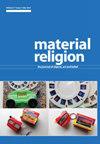Post-Secular Art for a Post-Secular Age: Stational Installations of the Via Dolorosa in Western cities
IF 0.4
3区 哲学
0 RELIGION
引用次数: 0
Abstract
Abstract Three installations of the “Stations of the Cross,” established as stational urban exhibitions across London, Washington, D.C., and New York in 2016, 2017, and 2018 (respectively), are the focus of this article, which examines the significance of the Via Dolorosa in Western culture and the role that visual media embodying this sacred topography have played in pre-modern and contemporary Western societies. It studies the contemporary installations in relation to sixteenth-century trend of superimposing the Via Dolorosa upon Western towns, and shows that the contemporary installations used the paradigm of the fourteen stations to contextualize themes that are entirely unrelated to Jerusalem or the Gospels but are highly significant within twenty-first-century Western cultural discourse. It discusses the way in which these installations bridged the gap between religious and secular worldviews in a post-secular age, studying them as a form of post-secular art.后世俗时代的后世俗艺术:多洛罗萨大街在西方城市的静态装置
摘要2016年、2017年和2018年,作为伦敦、华盛顿特区和纽约的站点城市展览,“十字车站”的三个装置是本文的重点,它考察了多洛罗萨大街在西方文化中的意义,以及体现这一神圣地形的视觉媒体在前现代和当代西方社会中所扮演的角色。它研究了与16世纪将多洛罗萨大街叠加在西方城镇上的趋势相关的当代装置,并表明当代装置使用了十四个车站的范式来将与耶路撒冷或福音书完全无关但在21世纪西方文化话语中具有高度意义的主题置于情境中。它讨论了这些装置如何在后世俗时代弥合宗教和世俗世界观之间的差距,并将其作为后世俗艺术的一种形式进行研究。
本文章由计算机程序翻译,如有差异,请以英文原文为准。
求助全文
约1分钟内获得全文
求助全文

 求助内容:
求助内容: 应助结果提醒方式:
应助结果提醒方式:


